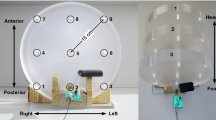Abstract
Fast scan techniques, which are used to reduce scanning times, have raised scanning noise levels in magnetic resonance imaging (MRI) systems, resulting in greater patient discomfort and stress. It is well known that this noise is caused by vibration of the gradient coil due to the Lorentz forces generated by the current in the gradient coil, which is placed in a static magnetic field. We have confirmed that MRI noise can be substantially reduced by sealing the gradient coil in a vacuum chamber to block airborne vibration propagation, by supporting the gradient coil independently to block solid vibration propagation and by decreasing the eddy currents induced in RF coils, the RF shield and the static-field-magnet cryostat. Based on these findings, we have developed a silent MRI system in which scanning noise is markedly reduced under a wide range of scanning conditions.
Similar content being viewed by others
References
Hennel F, Girard F, Loenneker T. “Silent” MRI with soft gradient pulses. Magn Reson Mod 1999;42:6–10.
Hedeen R. Edelstein W. Characterization and prediction of gradient acoustic noise in MR imagers. Magn Reson Med 1997;37:7–10.
Foster J, Hall D, Summerfield A, Palmer A, Bowtell R. Sound-level measurements and calculations of safe noise dosage during EPI at 3 T. J Magn Reson Imaging 2000;12:157–63.
Mcjury M. Shellock F. Auditory noise associated with MR procedures. J Magn Reson Imaging 2000;12:37–45.
Mansfield P. Glover P, Beaumont J. Sound generation in gradient coil structures for MRI. Magn Reson Med 1998;39:539–50.
Price D, De Wilde J, Papadaki A, Curran J, Kitney R. Investigation of acoustic noise on 15 MRI scanners from 0.2 T to 3 T. J Magn Reson Imaging 2001;13:288–93.
Furukawa H. Magnetic resonance imaging apparatus. US Patent 5,489,848, 1995.
Pla FG. Low noise MRI scanner. US Patent 5,793,210, 1996.
Price D, Wilde J, Papadaki A, Curran J, Kitney R. Acoustic noise on 1.5 T MRI systems. Int Soc Magn Reson Med 2001:1763.
Lord Rayleigh. Theory of sound, vol. 2. New York: Dover. 1945, p. 3.
Hunt FV. American Institute of Physics handbook. New York: McGraw-Hill, 1957, p. 3–28.
Lamb H. Hydrodynamics. 6th ed. Cambridge, 1963, chap. 1.
Mansfield P. Chapman B. Active magnetic screening of gradient coils in NMR imaging. J Magn Reson 1986;66:573–6.
Chapman B, Mansfield P. Double active magnetic screening of coils in NMR. J Phys D: Appl Phys 1986;19:L129–31.
Roemer PB, Hickley JS. Self-shielded gradient coils for nuclear magnetic resonance imaging. US Patent 4,737,716, 1986.
Turner R. A target field approach to optimal coil design. J Phys D: Appl Phys 1986; 19:L147–51.
Shvartsman Sh, Brown R, Cheng Y. Eagan T. Fujita H, Morich M, et al. Application of the SUSHI method to the design of gradient coils. Magn Reson Med 2001;45:147–55.
Author information
Authors and Affiliations
Corresponding author
Rights and permissions
About this article
Cite this article
Katsunuma, A., Takamori, H., Sakakura, Y. et al. Quiet MRI with novel acoustic noise reduction. MAGMA 13, 139–144 (2001). https://doi.org/10.1007/BF02678588
Received:
Revised:
Accepted:
Issue Date:
DOI: https://doi.org/10.1007/BF02678588




